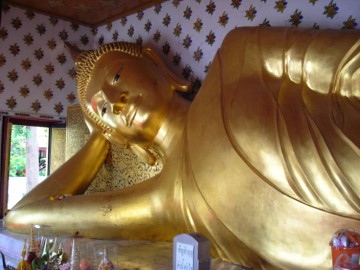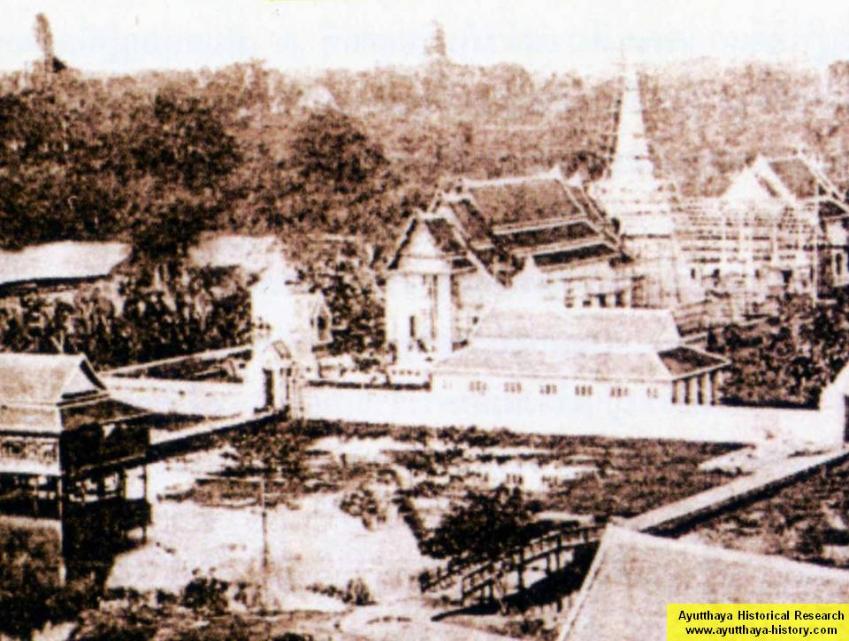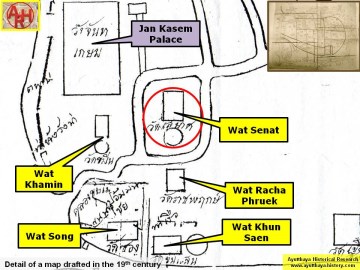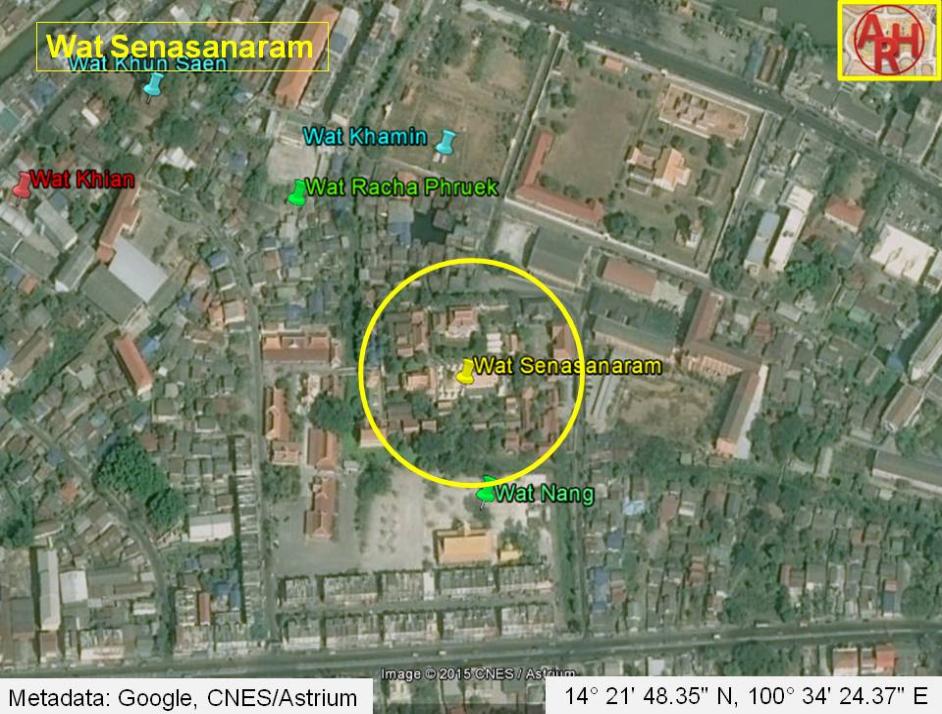| WAT SENASANARAM (วัดเสนาสนาราม) |
| Wat Senasanaram is an active temple. It is presently located roughly behind the Chan Kasem National Museum (the former Front Palace). Khlong Pratu Ho Ratanachai and Khlong Senasanaram partially encircles this monastery today, though the canal served as a moat for the Front Palace in earlier times. This monastery may be difficult for some people to find. It can also be reached by walking to the northern end of Khlong Makham Riang (formally known as Khlong Nai Kai). As an active monastery, Wat Senasanaram has all the basic structures of a Buddhist temple. There is a large sermon hall with beautifully decorated murals within. On the eastern side of this sermon hall is a large statue of a reclining Buddha that is painted gold. The central chedi is bell-shaped and painted gold as well. A number of small white chedi are scattered beside the large golden one. Two sacred Buddha images - Phra Phuttha Sai-yat and Phra Inplaeng - are housed in buildings on site. In addition, this monastery houses a pulpit and a teakwood boat, which were given to the monastery as gifts from King Chulalongkorn. This monastery is large and there are several monk’s quarters and a library in situ. The temple courtyard is kept impeccably clean. Wat Senasanaram was originally located on the site of an older temple named Wat Sua - the Tiger Temple. This monastery was situated behind the Front Palace, but was incorporated when palace grounds were extended (Amatyakul 42). It fell into ruin after the Burmese invasion in 1767. King Mongkut (r. 1851-1868) rebuilt and renamed the monastery in 1863. King Mongkut was a devout Buddhist who founded a strict sect of reformist monks known as Thammayut. His son, Prince Wachirayan, become the Supreme Patriarch of this reformist sect, and Wat Senasanaram became the first temple in Ayutthaya to practice Thammayut discipline (but it is now practiced at Wat Tum and others as well). King Mongkut believed that better education would contribute to his reform movements, so monastery schools were set up across the provinces and monks were encouraged to learn modern pedagogical methods. Provincial nobility served apprenticeships at these schools in order to qualify for jobs as civil servants. Government officials helped Thammayut monks by helping with correspondence, distributing textbooks and handling money; since monks of this sect are not allowed to touch it (Bunnag 180). King Chulalongkorn (1868-1910) continued with national reforms and sought to modernize the country. Therefore, he made Ayutthaya the provincial center for education and administration. The "new" city’s hospital, police station, courthouse, and prison were all located within walking distance from Wat Senasanaram. This gave the monastery even greater importance, and so King Chulalongkorn made further renovations to Wat Senasanaram in 1884. Wat Senasanaram became an important school during King Chulalongkorn’s reign. Children studied here at the primary and secondary levels. The monastery was also used for the training of the city’s first secular teachers before the city college took over the role in 1902 (as an early precursor to the Rajaphat University). Eventually, the Ministry of Education took over the role of administrating over local schools and Wat Senasanaram reverted back to its primary role as a monastery. It remains an active temple today and still receives royal patronage. |

| Text & photographs by Ken May - August 2009 Maps & photo show by Tricky Vandenberg - June 2015 |




'Khlong Maphrao' in the original text was changed by 'Khlong Ho Ratanachai and
Khlong Senasanaram'. (Tricky Vandenberg, 23 November 2013)
Khlong Senasanaram'. (Tricky Vandenberg, 23 November 2013)

| (View of the premises) |
| (Reclining Buddha at Wat Senasanaram) |
| (View of the premises) |
| (Chedi at Wat Senasanaram) |



| (Detail of a 19th century map - Courtesy of the Sam Chao Phraya Museum - map is orientated S-N) |
| (Detail of Phraya Boran Rachathanin's map - Anno 1926) |
| (Detail of a 2007 Fine Arts Department GIS map - Courtesy of the Fine Arts Department - 3th Region) |

| (Old photograph of Wat Senasanaram, an active temple located on Ayutthaya's city island in the northeastern part of the city in Hua Ro Sub-district.) |